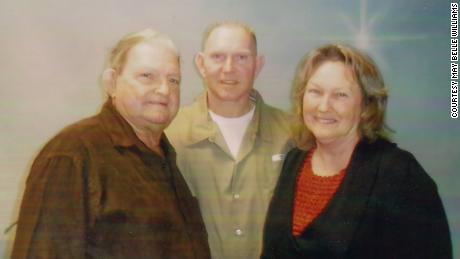Russ soon got another call: James, a 65-year-old inmate with diabetes and HIV, had tested positive for the virus himself. Within days, he was rushed to a hospital as his oxygen levels plummeted. A few weeks later, after his condition deteriorated and he was placed on a ventilator, he was dead.
Five Seagoville inmates told CNN in phone interviews from behind bars that they feared for their lives as the virus rushed through the Dallas-area prison, and that the crowded conditions made it all but impossible for them to stay socially distanced.
“It came through here so fast that it’s out of control,” said Bobby Williams, an immunocompromised inmate who has about three years left on a more than two-decade drug sentence. He said he came down with severe pneumonia after contracting Covid-19 in June. “We’re packed like sardines.”
released from prison to home confinement.
The BOP declined repeated requests for an interview with officials at Seagoville or national officials involved in setting coronavirus policy. A spokesperson said the agency distributed cloth masks to every inmate and guard, began mass testing of inmates in the prison by late June and stepped up sanitation procedures, among other policy changes.
once held Japanese and German detainees during World War II, among others — is now a cautionary tale for how quickly the coronavirus can take deadly hold in correctional facilities.
Since the beginning of May, when there was only a single coronavirus case at Seagoville, the number of inmates who have tested positive has soared to 1,333, according to BOP data (including prisoners at a minimum-security camp next to the prison). Twenty-eight of the roughly 300 prison employees have also tested positive.
The outbreak means that the facility has more coronavirus cases than about 85% of the counties in the US.
Dr. Homer Venters, the former chief medical officer for New York City’s jail system, who has inspected federal prisons’ coronavirus response plans, said outbreaks at Seagoville and other prisons were like “popcorn kernels popping off over an extended period of time.”
“There are many facilities that either have gone through the same thing or will,” he predicted. “This is really a tragic situation that’s playing out all over the country.”
Early release programs fall short
Prisoner rights advocates say that the BOP has fallen short on the most effective way to save inmate lives: reducing the number of vulnerable people inside the prisons.
home confinement, which is granted based on factors like inmates’ age, risk factors for Covid-19, the seriousness of their offense and their conduct in prison. Manafort and several other high-profile inmates were released under this method, which was expanded under the CARES Act earlier this year.
data released by the agency, out of the more than 157,000
total in the federal system. A spokesperson declined to provide specific numbers for Seagoville or other individual prisons, citing “the fluid nature of the pandemic situation.”
First Step criminal justice reform act in 2018. Inmates with health issues can ask a judge to reduce their sentence; they can also apply to their warden for the federal government to file a court motion for release on their behalf. So far, roughly 900 additional inmates have been released through that track this year, according to Families Against Mandatory Minimums, a criminal justice reform group that has helped recruit attorneys to represent inmates in coronavirus cases.
But criminal justice experts call the releases so far a drop in the bucket compared with the vast numbers of elderly and medically vulnerable people in federal custody. Kevin Ring, the president of FAMM, said federal officials had been arguing in court against many inmates who have petitioned for compassionate release.
“It’s been disappointing because most of these people were elderly and sick and now they’re the most at risk from this disease,” Ring said, arguing that the Trump administration “should have been clearing these people out.”
Instead, he said, officials were “slow to react” when the coronavirus started its deadly march through prisons around the country. “We’ve watched it hop from facility to facility — when it hits one, it ravages it,” Ring said. “It has been terrifying to watch.”
Nationally, more than 10,000 federal inmates and 1,300 BOP employees have tested positive for coronavirus, while 111 inmates and one staffer have died.
saying the conditions in the facility had possibly reached the level of “cruel and unusual punishment.” But an appeals court
struck down that order in June, finding that the inmates did not prove the BOP was “deliberately indifferent” to the risks presented by Covid-19.
House hearing last week. Barr said he had nothing to do with the decision to send Manafort home but noted that the department had released thousands of inmates.
policy, inmate George Reagan told CNN.
The BOP spokesperson said the agency didn’t comment on specific inmates’ requests for early release.
For some inmates, the potential of early release came too late. Giannetta, a Massachusetts native who was serving a 14-year sentence for selling methamphetamine and other charges, applied for an early release from the warden and was denied, according to a filing by his court-appointed lawyer. The lawyer submitted an expedited motion for compassionate release on July 3, after he had already tested positive and been sent to a hospital. A judge dismissed the petition as moot after Giannetta died at the hospital on July 16.
Giannetta’s older brother Russ, a physics professor at the University of Illinois, said in an interview that he had sent medical documents outlining his brother’s myriad health issues to officials at the prison and even wrote a letter to the Centers for Disease Control and Prevention, but his pleas for help didn’t seem to have any effect.
The Seagoville facility was a “petri dish,” Russ said. He said James knew even before he tested positive that he was in real danger: “He had a pretty good premonition that this was not a place that was going to be able to contain this virus if it broke out.”
Prison struggles to respond to outbreak
In interviews, inmates at Seagoville described a chaotic response to the outbreak by prison officials, whose efforts to slow the spread of the virus were hampered by delayed test results and a lack of enforcement of mask-wearing policies.
Bobby Williams, who has skin cancer and takes medicine that reduces his immune response, said he came down with pneumonia after testing positive for the virus. “I thought I was going to die,” he said. “I was passing out, I couldn’t breathe.”
He said doctors at the prison gave him steroid shots and a nasal spray that helped, but over a month later, he still feels the impact from the virus. Williams, 56, has been in federal prison for 22 years and has about three-and-a-half years left to go on drug and money laundering convictions.
Venters, the former New York jail medical officer, has conducted dozens of inspections of coronavirus response efforts in prisons and jails around the country, including BOP facilities. He said that while he hadn’t inspected Seagoville, the numbers and stories shared by inmates were troubling.
“What I’ve found over and over is there is no special protections or special surveillance for high-risk patients,” Venters said. In many BOP facilities, he said, “I have observed very large numbers of people in very close quarters, which makes the spread of this virus inevitable once somebody becomes sick.”
disputed evidence, said that he and other inmates faced a four-day delay between taking a test and getting the result last month — which meant that the prison didn’t move some positive inmates out of the general population until it was too late.
The BOP spokesperson said Seagoville was using a rapid 15-minute test machine as well as commercial lab tests that have turnaround times of three to 10 days.
Severns, who tested positive and was mostly asymptomatic, said he is now living with five roommates — all of whom have also tested positive — in a small former TV room converted to housing.
“I was amazed just how fast (the virus) went, once it started going,” he said. “I think everybody here’s going to get it.”
Mask wearing has been spotty among both guards and inmates, several inmates said, although they added that more people in the prison are now wearing masks regularly in the last week or two as cases have shot up.
Joseph Perrone, who said he is scheduled to go to a halfway house in a few weeks after about a decade in prison for selling cocaine, said he suffered headaches, a loss of smell and the worst muscle aches of his life after testing positive. “It felt like somebody beat me,” he said.
Perrone, 55, who said he worked in the prison’s food service at the beginning of the outbreak, said most of the guards overseeing him weren’t wearing their masks at the time and “they didn’t make us wear ours.”
“I was going to work and I’m sure I was infecting people,” he said.
Now, as the cases have reached a level that could result in a form of herd immunity in the prison, officials are starting to move operations back to normal, according to a memo to inmates that several described to CNN. Coronavirus-positive inmates who are symptom-free for 10 days will be considered recovered in most cases, and they will start to be moved back to their original housing locations soon, the memo said.
statistics, 1,287 inmates at the prison have recovered from Covid-19, while 46 still have active cases.
Beyond the prison walls
Visitation has been shut down at Seagoville and other federal prisons for months — but outbreaks behind bars can still spread to local communities as guards and other employees go back and forth to work.
Correctional officers at the facility say they’re scared to walk inside the prison’s walls, especially because while the agency has tested most of the inmates, it hasn’t done the same for the prison’s 283 employees.
Anthony Simon, a case worker at the prison and a representative for the local union, said he had appealed to the management for broader testing. When he comes home from working at the prison or attending to inmates at a local hospital, Simon said, he strips off his clothes, puts them in a bag and showers before even greeting his wife.
“Everyone’s worried they could bring it home to their family,” Simon said. “But you’re still required to go to work — we can’t leave the inmates by themselves and say we’ll come back later.”
The BOP spokesperson said the agency couldn’t require employees to get tested, but it’s providing staff who come in close contact with Covid-19-positive inmates a letter to public health departments that can help them get prioritized for testing.
study of Chicago’s Cook County Jail found that inmates going in and out of the jail may be linked with more than 15% of all the virus cases in Illinois as of April.
Still, local officials in Dallas County said they didn’t think that Seagoville was having a major impact outside the prison itself. The prison outbreak “has not strained our local health resources as the facility has handled their own response and contact tracing,” said Lauren Trimble, the chief of staff for the Dallas County Judge, the county’s top executive.
Family members of inmates have organized several protests in front of the prison in recent months. One of the protest organizers, Tabitha Wheeler-Reagan, a Dallas entrepreneur and activist whose husband is a Seagoville inmate, said she thought people in the community weren’t paying enough attention to the human suffering in the prison.
Her husband George Reagan, 55, who is scheduled to be released from a more than 5-year drug sentence next year, was sharing a cell with another inmate who got coronavirus in late June, she said. Reagan tested negative twice, so the prison didn’t isolate him from the other inmates, Wheeler-Reagan said.
Then, early last month, Reagan called his wife with ominous news: he had lost his sense of taste. She said she immediately called the prison and demanded he get tested again. Once he did, he tested positive.
Wheeler-Reagan said she thinks the prison leadership didn’t take the outbreak seriously enough early on and the guards didn’t have proper training about how to respond. She was confused why prison officials rejected her husband’s bid for home confinement during the pandemic, especially considering he has heart disease and he’ll likely be eligible to go to a halfway house later this year, she said.
“I one hundred percent don’t think that the federal government cares at all,” Wheeler-Reagan said. “This is one of those situations where they can’t blame anybody but themselves.”
CNN’s Collette Richards contributed to this report.











